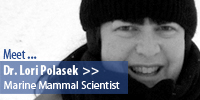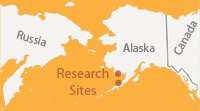 |
 |
 |
 |
 |
 |
 |
 |
2012 Updates from Bristol Bay
In May 2012, the researchers returned to Bristol Bay. Installing cameras was again a big adventure. After their plane broke down, the team unexpectedly spent a night sleeping on the beach of a remote island!
Check out some of their observations from the 2012 season! We'll continue adding data as more is analyzed over the winter.
Cape Seniavin Disturbance (click to download .pdf)
VIDEO: Foot Traffic Disturbance
Walruses at Cape Seniavin are disturbed by people walking along the beach. (1 minute)
Sometimes just the presence of people on the beach is enough to disturb walrus. These folks might not have known it, but the Marine Mammal Protection Act makes it illegal to get within 100 yards of any marine mammal.
VIDEO: Airplane Disturbance
Walruses at Cape Seniavin are disturbed by an airplane flying overhead. (1 minute)
Just the sound of a plane flying low overhead was enough to disturb these walrus at Cape Seniavin. Scientists are curious what impact repeated disturbances (like planes flying over daily or people using the area regularly) might have on the number of walrus using a haulout.
Next Steps
In the summer of 2012, the scientists took a huge step. They installed their first cameras along the Chukchi Sea near the village of Point Lay, Alaska. Dr. Lori Polasek hoped that, if the season's sea ice melted past the edge of the walruses' normal range, the animals might choose to haulout on land in this area. She had good reason to expect this, because walrus had hauled out near Point Lay twice in recent summers.
Since the beach in this area is so flat, the team could not rely on cliffs or other natural features to provide good vantage points for their cameras. Instead, they constructed a tower. The tower was designed so that local volunteers could rotate the camera angles depending on where along the beach the walrus had hauled out. However, the team didn't get any data from the Point Lay cameras in 2012. This time, it wasn't because the cameras failed to work. Instead, sea ice remained available in that area, so no walrus hauled out at the site this year.
An organization called the National Snow and Ice Data Center works together with NASA to monitor sea ice coverage in the Arctic using satellites. Data is collected daily and is used to form models that help scientists predict how much sea ice will cover the Arctic during different times of the year. Satellite monitoring of Arctic sea ice began in 1979. When scientists compare historical data with recent ice conditions, they can say with confidence that conditions in the Arctic are changing. In fact, satellite data shows that the amount of sea ice covering the Arctic was lower in the summer of 2012 than in any other year since monitoring began!
So why didn't walrus haul out on land in Alaska if there was less sea ice in the Arctic than ever before? It all comes down to the distribution of ice. Although there was less ice overall in 2012, patchy areas of ice remained floating in the Chukchi Sea. There was enough floating sea ice to allow females and calves to stay near their feeding grounds without having to move to land-based haulouts.
This year's results don't mean the end of the research project and Dr. Lori Polasek isn't abandoning the idea of monitoring haulouts in the Chukchi Sea. In fact, the team hopes to add more monitoring sites along this area in upcoming years. Global climate patterns are changing and the impact is evident in the Arctic. These changes are visible in warmer-than-average annual global temperatures and in a decrease in the extent of summer sea ice in the Arctic over many decades. Climate scientists know that looking at the conditions in one year doesn't paint a clear picture of long-term conditions in the Arctic. In the same way, the walrus research team recognizes that, just because walrus did not use Alaska land-based haulouts along the Chukchi in 2012, it doesn't mean they won't rely on these areas in the future.
Stay tuned for more information as this research project continues.
In the mean time, educate yourself about how humans are impacting climate in the Arctic and around the globe. Do your part to help lessen our impact: learn about your carbon footprint and about what earth-friendly actions you can take in your everyday life.
Dr. Lori Polasek and her team would like to thank all the sponsors and partners for this research project, including the Alaska Department of Fish and Game, Defenders of Wildlife, the National Fish and Wildlife Foundation, SeaWorld & Busch Garden’s Conservation Fund, and the United States Fish and Wildlife Service.
2012 Updates from US Geological Survey
Walruses at Cape Seniavin are disturbed by people walking along the beach. (1 minute)







